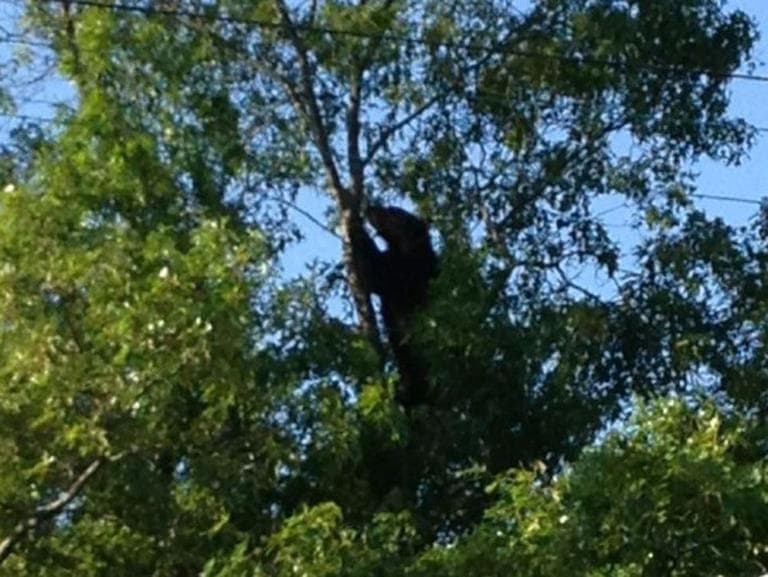Advertisement
In Mass., Trees (And French Fries) Bring The Black Bears Back
The young black bear shot and killed by the Massachusetts Environmental Police in Newton Sunday morning spent his final moments amid the thick, green leaves of a tall tree.
It was, in a way, a fitting shroud.
The story of the Massachusetts black bear's revival — and spread to the more populated, eastern portion of the state — has a lot to do with trees.

Laura Conlee, black bear project leader with the Massachusetts Division of Fisheries and Wildlife, said a survey of city and town records dating back to the 1600s shows that settlers who cleared the forest for agriculture drove the bear population to "very, very low numbers" over the centuries.
And the Massachusetts story was not a unique one. More farmland meant less wildlife throughout the Northeast.
But as Jim Sterba, author of "Nature Wars: The Incredible Story of How Wildlife Comebacks Turned Backyards into Battlegrounds," writes, 19th century New England was the locus for U.S. reforestation.
With the opening of the Erie Canal, farmers were able to drop marginal pastures and look west for cheap feed, planted on flatter land.
Over time, technological advances in machinery and fertilizer made Midwestern farming more and more efficient — and New England farming less and less viable.
After World War II, lawyers and shop owners and insurance salesmen filled the spaces once occupied by farmers. And the landscape grew leafier.
Some two-thirds of the Bay State is now forested. That's meant a return of wild turkeys and fishers, members of the weasel family. And the black bear population grew from about 100 in 1970 to 4,000 now, according to Conlee.
[sidebar title="Tracking Bears" width="350" align="right"]
Massachusetts state officials run one of the longest continuous studies of black bears in the U.S.
Laura Conlee, black bear project leader with the Massachusetts Division of Fisheries and Wildlife, said the state began trapping, collaring and tracking the animals in 1980.
The focus of the project, at present, is adult females. Their survival — a relatively high 89 percent now make it from from one year to the next — is central to the growth of the Bay State's black bear population.
Wildlife officials have affixed collars to about 19 of the females, Conlee says. About half are outfitted with global positioning system (GPS) technology, half with cheaper very high frequency (VHF) technology emitting radio signals.
Officials check in on females and cubs in their winter dens. And they follow up a year later to see how many cubs have survived.
The collars also provide a window into the bears' wanderings — across highways, into residential areas. "We're going to utilize all that information to help generate a statewide habitat map," Conlee said, to "look at what areas within Massachusetts are really good bear habitat — and what areas within the eastern part of our state could actually support bears, because we do have that expanding population."
[/sidebar]
The resurgent wildlife in Massachusetts and down the Eastern Seaboard has come into contact with the biggest population center in the country.
"If you draw a line around the Great Eastern Forest from the Atlantic coast out to the Great Plains where the trees run out," Sterba said in an interview with WBUR, "you've got two-thirds of the U.S. population."
The eastern United States, he writes, may now have "more people liv[ing] in closer proximity to more wildlife than anywhere on Earth at any time in history."
That proximity means plenty of dumpsters and trash cans to entice bears and deer. "Our habitat, for lots of species of wildlife, is better than their habitat," Sterba said.
But when it comes to young male black bears like the one shot in Newton this weekend, said Conlee of the Division of Fisheries and Wildlife, the fast food littering the highway is not the only explanation for interspecies contact.
After about one-and-a-half years with their mothers, young males set out on their own and can travel 80 to 100 miles looking for a place to settle.
When they get older, they'll wander an area as large as 100 square miles looking for a mate.
Combine the wanderlust with the nourishment of forest and french fries, and more bears in suburbia seem like an inevitability.
This program aired on June 3, 2013. The audio for this program is not available.